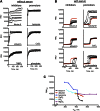Nanoparticle-based test measures overall propensity for calcification in serum
- PMID: 22956818
- PMCID: PMC3458464
- DOI: 10.1681/ASN.2012030240
Nanoparticle-based test measures overall propensity for calcification in serum
Abstract
Vascular and soft tissue calcification contributes to cardiovascular morbidity and mortality in both the general population and CKD. Because calcium and phosphate serum concentrations are near supersaturation, the balance of inhibitors and promoters critically influences the development of calcification. An assay that measures the overall propensity for calcification to occur in serum may have clinical use. Here, we describe a nanoparticle-based assay that detects, in the presence of artificially elevated calcium and phosphate concentrations, the spontaneous transformation of spherical colloidal primary calciprotein particles (CPPs) to elongate crystalline secondary CPPs. We used characteristics of this transition to describe the intrinsic capacity of serum to inhibit the precipitation of calcium and phosphate. Using this assay, we found that both the sera of mice deficient in fetuin-A, a serum protein that inhibits calcification, and the sera of patients on hemodialysis have reduced intrinsic properties to inhibit calcification. In summary, we developed a nanoparticle-based test that measures the overall propensity for calcification in serum. The clinical use of the test requires evaluation in a prospective study.
Figures





Similar articles
-
Novel assessments of systemic calcification propensity.Curr Opin Nephrol Hypertens. 2016 Jul;25(4):278-84. doi: 10.1097/MNH.0000000000000237. Curr Opin Nephrol Hypertens. 2016. PMID: 27228365 Review.
-
Serum calcification propensity predicts all-cause mortality in predialysis CKD.J Am Soc Nephrol. 2014 Feb;25(2):339-48. doi: 10.1681/ASN.2013060635. Epub 2013 Oct 31. J Am Soc Nephrol. 2014. PMID: 24179171 Free PMC article.
-
Chronic Kidney Disease Circulating Calciprotein Particles and Extracellular Vesicles Promote Vascular Calcification: A Role for GRP (Gla-Rich Protein).Arterioscler Thromb Vasc Biol. 2018 Mar;38(3):575-587. doi: 10.1161/ATVBAHA.117.310578. Epub 2018 Jan 4. Arterioscler Thromb Vasc Biol. 2018. PMID: 29301790
-
Lumenal calcification and microvasculopathy in fetuin-A-deficient mice lead to multiple organ morbidity.PLoS One. 2020 Feb 19;15(2):e0228503. doi: 10.1371/journal.pone.0228503. eCollection 2020. PLoS One. 2020. PMID: 32074120 Free PMC article.
-
Magnesium and calciprotein particles in vascular calcification: the good cop and the bad cop.Curr Opin Nephrol Hypertens. 2019 Jul;28(4):368-374. doi: 10.1097/MNH.0000000000000509. Curr Opin Nephrol Hypertens. 2019. PMID: 31045659 Review.
Cited by
-
Clinical Approach to Vascular Calcification in Patients With Non-dialysis Dependent Chronic Kidney Disease: Mineral-Bone Disorder-Related Aspects.Front Med (Lausanne). 2021 May 19;8:642718. doi: 10.3389/fmed.2021.642718. eCollection 2021. Front Med (Lausanne). 2021. PMID: 34095165 Free PMC article. Review.
-
Humoral and cellular factors inhibit phosphate-induced vascular calcification during the growth period.J Clin Biochem Nutr. 2023 Nov;73(3):198-204. doi: 10.3164/jcbn.23-11. Epub 2023 Jun 28. J Clin Biochem Nutr. 2023. PMID: 37970550 Free PMC article.
-
Shedding Light on the Complex Regulation of FGF23.Metabolites. 2022 Apr 28;12(5):401. doi: 10.3390/metabo12050401. Metabolites. 2022. PMID: 35629904 Free PMC article. Review.
-
Removal of calciprotein particles from the blood using an adsorption column improves prognosis of hemodialysis miniature pigs.Sci Rep. 2023 Sep 12;13(1):15026. doi: 10.1038/s41598-023-42273-0. Sci Rep. 2023. PMID: 37700060 Free PMC article.
-
Phosphate and Coronary Artery Disease in Patients with Chronic Kidney Disease.J Atheroscler Thromb. 2024 Jan 1;31(1):1-14. doi: 10.5551/jat.RV22012. Epub 2023 Sep 28. J Atheroscler Thromb. 2024. PMID: 37766573 Free PMC article. Review.
References
-
- Jahnen-Dechent W, Heiss A, Schäfer C, Ketteler M: Fetuin-A regulation of calcified matrix metabolism. Circ Res 108: 1494–1509, 2011 - PubMed
-
- Sandin K, Hegbrant J, Kloo L: A theoretical investigation of the supersaturation of basic calcium phosphate in serum of dialysis patients. J Appl Biomater Biomech 4: 80–86, 2006 - PubMed
-
- Thurgood LA, Ryall RL: Proteomic analysis of proteins selectively associated with hydroxyapatite, brushite, and uric acid crystals precipitated from human urine. J Proteome Res 9: 5402–5412, 2010 - PubMed
-
- Yusuf S, Reddy S, Ounpuu S, Anand S: Global burden of cardiovascular diseases: Part I: General considerations, the epidemiologic transition, risk factors, and impact of urbanization. Circulation 104: 2746–2753, 2001 - PubMed
-
- Blacher J, Guerin AP, Pannier B, Marchais SJ, London GM: Arterial calcifications, arterial stiffness, and cardiovascular risk in end-stage renal disease. Hypertension 38: 938–942, 2001 - PubMed
Publication types
MeSH terms
Substances
LinkOut - more resources
Full Text Sources
Other Literature Sources
Medical
Molecular Biology Databases

